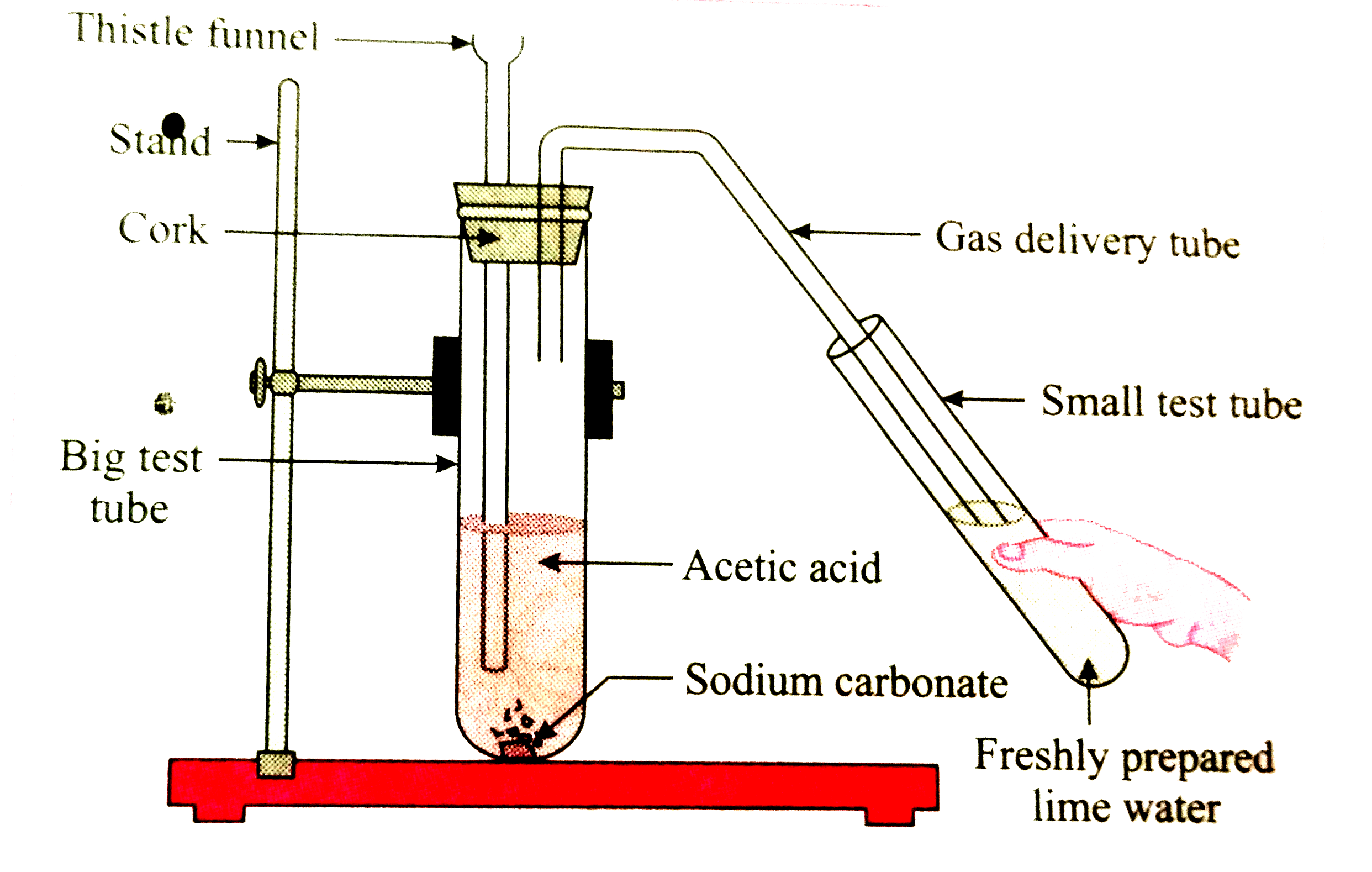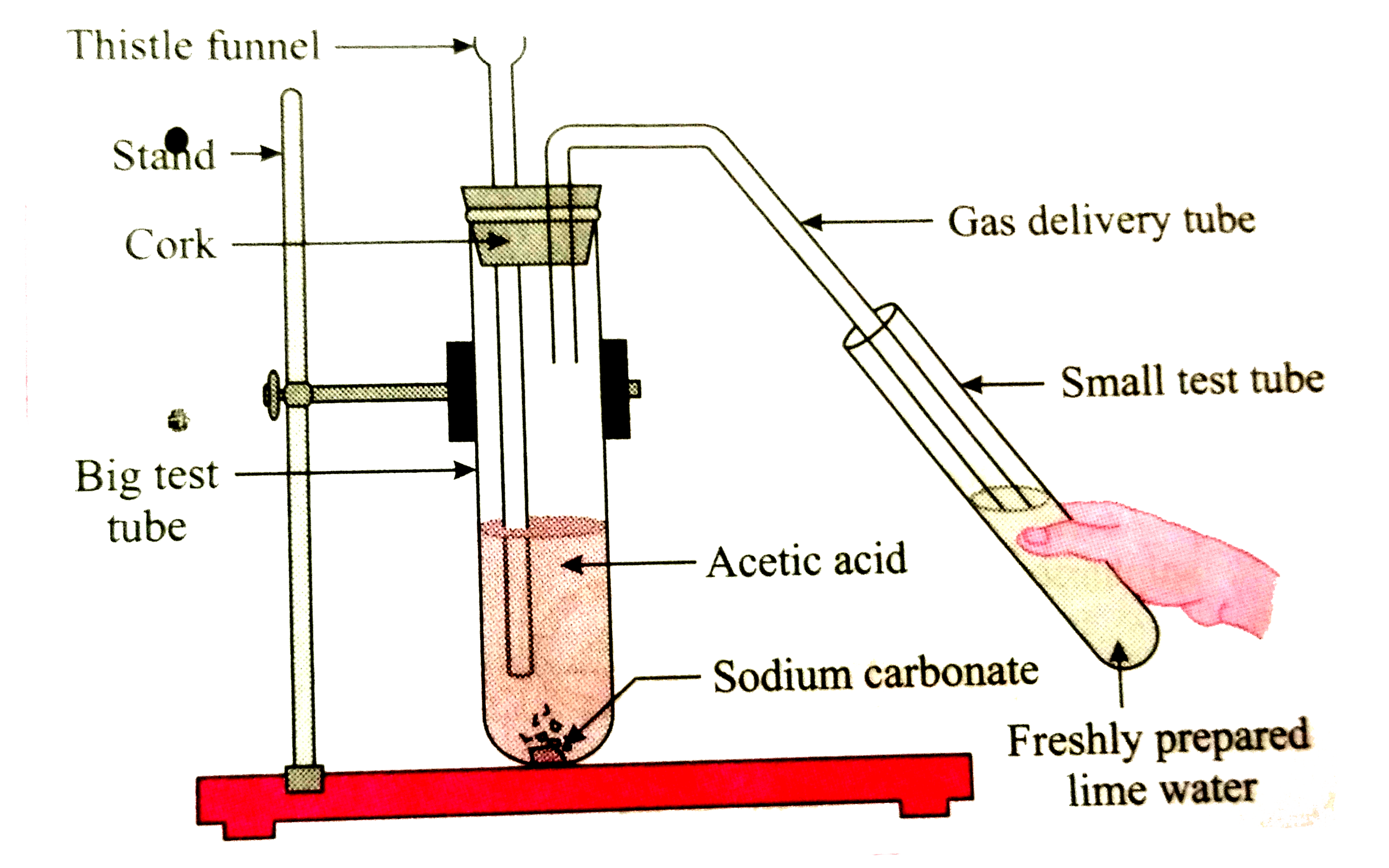Apparatus: Two test tubes, bent tube, rubber cork, burner, etc.
Chemicals: Calcium carbonate, freshly prepared lime water.
Procedure: Take some calcium carbonate in a test tube. Fit a bent tube to this test tube with the help of a rubber cork. Insert the other end of the bent tube in the freshly prepared lime water taken in the other test tube. Heat the powdered calcium carbonate in the first test tube strongly.
What will you observe? Solution in Marathi
In the second test tube, the lime water turns milky and in the first test tube, white powder remains behind. Calcium carbonate undergoes decomposition to form calcium oxide, the white powder and carbon dioxide gas, which turns lime water milky.
CaCO3(s)CalciumcarbonateΔ−−→CaO(s)Calciumoxide+CO2↑CarbondioxideInference: In this reaction, calcium carbonate decomposes into two products, CaO and CO2. Hence, this is a decomposition reaction. [Note: Students are expected to refer the accompanying QR code for demonstration of the activity.]
Topper's Solved these Questions
- CHEMICAL REACTIONS AND EQUATIONSBOOK - TARGET PUBLICATIONCHAPTER - CHEMICAL REACTIONS AND EQUATIONSEXERCISE - Chapter Assessment
31 Videos
- CHEMICAL REACTIONS AND EQUATIONSBOOK - TARGET PUBLICATIONCHAPTER - CHEMICAL REACTIONS AND EQUATIONSEXERCISE - Questions based on paragraph
20 Videos
- CARBON COMPOUNDSBOOK - TARGET PUBLICATIONCHAPTER - CARBON COMPOUNDSEXERCISE - Chapter Assessment(Give scientific reasons.)
3 Videos
- METALLURGYBOOK - TARGET PUBLICATIONCHAPTER - METALLURGYEXERCISE - CHAPTER ASSESSMENT
12 Videos
Similar Questions
The chemical formula of the rust is
View SolutionVeena observes that during winter setting of milk into curd takes more time while during summer, the same process happens faster. She asks about this difference in time taken to her elder sister. She also asks her sister about why certain reactions occur rapidly while others occur slowly. Her sister explains her about the various factors that affect the rate of chemical reactions. Based on the above scenario, answer the following questions.
Why do you think setting of curd occur at different rates during different seasons?
View SolutionState whether the following statements are true or false. If false then rewrite the correct statements: Carbon is tetravalent and it can undergo catenation.
View SolutionA student added zinc strip to a solution of CuSO4. After several minutes, he observed that the blue colour of solution changed and a layer got deposited on zinc strip. The colour of the solution and that of the coating would respectively be ______
View SolutionApparatus: Big test tube, small test tube, bent gas delivery tube, rubber cork, thistle funnel, stand, etc.
Chemical : Acetic acid, sodium carbonate power, freshly prepared lime water.
Procedure : Arrange the apparatus as shown in figure. Plance sodium carbonate powder in the big test tube. Pour 10 ml acetic acid through the thistle funnel. Observe the changes taking place in the two test tubes.

Which gas does come out as effervescence in the big test tube ?
View SolutionApparatus: Big test tube, small test tube, bent gas delivery tube, rubber cork, thistle funnel, stand, etc.
Chemical : Acetic acid, sodium carbonate power, freshly prepared lime water.
Procedure : Arrange the apparatus as shown in figure. Plance sodium carbonate powder in the big test tube. Pour 10 ml acetic acid through the thistle funnel. Observe the changes taking place in the two test tubes.

Why are bubbles seen in the small test tube ?
View SolutionApparatus: Big test tube, small test tube, bent gas delivery tube, rubber cork, thistle funnel, stand, etc.
Chemical : Acetic acid, sodium carbonate power, freshly prepared lime water.
Procedure : Arrange the apparatus as shown in figure. Plance sodium carbonate powder in the big test tube. Pour 10 ml acetic acid through the thistle funnel. Observe the changes taking place in the two test tubes.

What is the colour change in the lime water? Write the related equation.
View SolutionApparatus: Two test tubes, bent tube, rubber cork, burner, etc. Chemicals: Calcium carbonate, freshly prepared lime water. What will you study using above apparatus and chemicals? Draw neat labelled diagram for the experimental setup.
View SolutionApparatus: Two test tubes, bent tube, rubber cork, burner, etc. Chemicals: Calcium carbonate, freshly prepared lime water. Name the gas evolved when calcium carbonate is heated.
View SolutionApparatus: Two test tubes, bent tube, rubber cork, burner, etc. Chemicals: Calcium carbonate, freshly prepared lime water. Name the solid product left behind on heating calcium carbonate.
View SolutionApparatus: Two test tubes, bent tube, rubber cork, burner, etc. Chemicals: Calcium carbonate, freshly prepared lime water. What are the products formed when evolved gas reacts with freshly prepared lime water?
View SolutionApparatus: Two test tubes, bent tube, rubber cork, burner, etc. Chemicals: Calcium carbonate, freshly prepared lime water. Procedure: Take some calcium carbonate in a test tube. Fit a bent tube to this test tube with the help of a rubber cork. Insert the other end of the bent tube in the freshly prepared lime water taken in the other test tube. Heat the powdered calcium carbonate in the first test tube strongly. What will you observe?
View SolutionApparatus: Big test tube, delivery tube fitted in a rubber cork, knife, candle, etc. Chemicals : Sodium metal, ethanol, magnesium ribbon, etc. Procedure : Take 10 mL ethanol in a big test tube. Cut Sodium metal into 2-3 pieces of a cereal grain size. Put the sodium pieces into the ethanol in the test tube and fix the gas delivery tube to the test tube. Take a burning candle near the outlet of the gas delivery tube and observe. Does magnesium metal react with ethanol?
View SolutionApparatus: Two test tubes, bent tube, rubber cork, burner, etc. Chemicals: Calcium carbonate, freshly prepared lime water. What will you study using above apparatus and chemicals? Draw neat labelled diagram for the experimental setup.
View SolutionApparatus: Two test tubes, bent tube, rubber cork, burner, etc.
Chemicals: Calcium carbonate, freshly prepared lime water.
Name the solid product left behind on heating calcium carbonate.
View Solution
